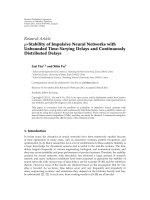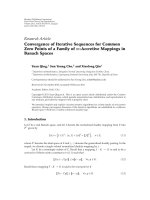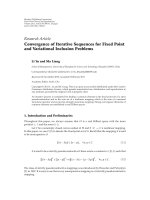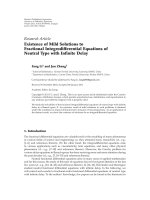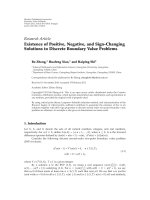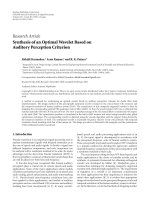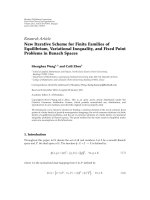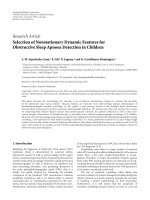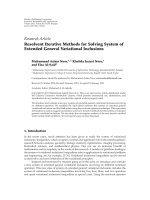Báo cáo hóa học: " Research Article Convergence of Paths for Perturbed Maximal Monotone Mappings in Hilbert Spaces" potx
Bạn đang xem bản rút gọn của tài liệu. Xem và tải ngay bản đầy đủ của tài liệu tại đây (492.75 KB, 9 trang )
Hindawi Publishing Corporation
Fixed Point Theory and Applications
Volume 2010, Article ID 547828, 9 pages
doi:10.1155/2010/547828
Research Article
Convergence of Paths for Perturbed Maximal
Monotone Mappings in Hilbert Spaces
Yuan Qing,
1
Xiaolong Qin,
1
Haiyun Zhou,
2
and Shin Min Kang
3
1
Department of Mathematics, Hangzhou Normal University, Hangzhou 310036, China
2
Department of Mathematics, Shijiazhuang Mechanical Engineering College, Shijiazhuang 050003, China
3
Department of Mathematics, Gyeongsang National University, Jinju 660-701, Republic of Korea
Correspondence should be addressed to Shin Min Kang,
Received 16 July 2010; Revised 30 November 2010; Accepted 20 December 2010
Academic Editor: Ljubomir B. Ciric
Copyright q 2010 Yuan Qing et al. This is an open access article distributed under the Creative
Commons Attribution License, which permits unrestricted use, distribution, and reproduction in
any medium, provided the original work is properly cited.
Let H be a Hilbert space and C a nonempty closed convex subset of H.LetA : C →
H be a maximal monotone mapping and f : C → C a bounded demicontinuous strong
pseudocontraction. Let {x
t
} be the unique solution to the equation fxx tAx. Then{x
t
} is
bounded if and only if {x
t
} converges strongly to a zero point of A as t →∞which is the unique
solution in A
−1
0,whereA
−1
0 denotes the zero set of A, to the following variational inequality
fp − p, y − p≤0, for all y ∈ A
−1
0.
1. Introduction and Preliminaries
Throughout this work, we always assume that H is a real Hilbert space, whose inner product
and norm are denoted by ·, · and ·, respectively. Let C be a nonempty closed convex
subset of H and A a nonlinear mapping. We use DA and RA to denote the domain and
the range of the mapping A. → and denote strong and weak convergence, respectively.
Recall the following well-known definitions.
1 A mapping A : C → H is said to be monotone if
Ax − Ay, x − y
≥ 0, ∀x, y ∈ C. 1.1
2 The single-valued mapping A : C → H is maximal if the graph GA of A is not
properly contained in the graph of any other monotone mapping. It is known that a
monotone mapping A is maximal if and only if for x, Ax ∈ H×H, x−y, Ax−
g≥0
for every y, g ∈ GA implies g Ay.
2 Fixed Point Theory and Applications
3 A : C → H is said to be pseudomonotone if for any sequence {x
n
} in C which
converges weakly to an element x in C with lim sup
n →∞
Ax
n
,x
n
− x≤0 we have
lim inf
n →∞
Ax
n
,x
n
− y
≥
Ax, x − y
, ∀y ∈ C.
1.2
4 A : C → H is said to be bounded if it carries bounded sets into bounded sets; it is
coercive if Ax, x/x→∞as x→∞.
5 Let X, Y be linear normed spaces. T : DT ⊂ X → Y is said to be demicontinuous if,
for any {x
n
}⊂DT we have Tx
n
Tx
0
as x
n
→ x
0
.
6 Let T be a mapping of a linear normed space X into its dual space X
∗
. T is said to be
hemicontinuous if it is continuous from each line segment in X to the weak topology
in X
∗
.
7 The mapping f with the domain Df and the range Rf in H is said to be
pseudocontractive if
f
x
− f
y
,x− y
≤
x − y
2
, ∀x, y ∈ D
f
.
1.3
8 The mapping f with the domain Df and the range Rf in H is said to be strongly
pseudocontractive if there exists a constant β ∈ 0, 1 such that
f
x
− f
y
,x− y
≤ β
x − y
2
, ∀x, y ∈ D
f
.
1.4
Remark 1.1. For the maximal monotone operator A, we can defined the resolvent of A by
J
t
I tA
−1
,t>0. It is well know that J
t
: H → DA is nonexpansive.
Remark 1.2. It is well-known that if T is demicontinuous, then T is hemicontinuous, however,
the converse, in general, may not be true. In reflexive Banach spaces, for monotone mappings
defined on the whole Banach space, demicontinuity is equivalent to hemicontinuity.
To find zeroes of maximal monotone operators is the central and important topics in
nonlinear functional analysis. We observe that p is a zero of the monotone mapping A if
and only if it is a fixed point of the pseudocontractive mapping T : I − A. Consequently,
considerable research works, especially, for the past 40 years or more, have been devoted
to the existence and convergence of zero points for monotone mappings or fixed points of
pseudocontractions, see, for instance, 1–23 .
In 1965, Browder 1 proved the existence result of fixed point for demicontinuous
pseudocontractions in Hilbert spaces. To be more precise, he proved the following theorem.
Theorem B1. Let H be a Hilbert space, C a nonempty bounded and closed convex subset of H and
T : C → C a demicontinuous pseduo-contraction. Then T has a fixed point in C.
In 1968, Browder 4 proved the existence results of zero points for maximal monotone
mappings in reflexive Banach spaces. To be more precise, he proved the following theorem.
Fixed Point Theory and Applications 3
Theorem B2. Let X be a reflexive Banach space, T
1
: DT
1
⊆ X → 2
X
∗
a maximal monotone
mapping and T
2
a bounded, pseudomonotone and coercive mapping. Then, for any h ∈ X
∗
,thereexists
u ∈ X such that h ∈ T
1
T
2
u,orRT
1
T
2
is all of X
∗
.
For the existence of continuous paths for continuous pseudocontractions in Banach
spaces, Morales and Jung 15 proved the following theorem.
Theorem MJ. Let E be a Banach space. Suppose that C is a nonempty closed convex subset of E and
T : C → E is a continuous pseudocontraction satisfying the weakly inward condition. Then for each
z ∈ C, there exists a unique continuous path t → y
t
∈ C, t ∈ 0, 1, which satisfies the following
equation y
t
1 − tz tTy
t
.
In 2002, Lan and Wu 14 partially improved the result of Morales and Jung 15 from
continuous pseudocontractions to demicontinuous pseudocontractions in the framework of
Hilbert spaces. To be more precise, they proved the following theorem.
Theorem LW. Let K be a bounded closed convex set in H. Assume that T : K → H is a
demicontinuous weakly inward pseudocontractive map. Then T has a fixed point in K. Moreover;
for every x
0
∈ K, {x
t
} defined by x
t
1 − tTx
t
tx
0
converges to a fixed point of T.
In this work, motivated by Browder 3, Lan and Wu 14, Morales and Jung 15,
Song and Chen 19,andZhou22, 23 , we consider the existence of convergence of paths for
maximal monotone mappings in the framework of real Hilbert spaces.
2. Main Results
Lemma 2.1. Let C be a nonempty closed convex subset of a Hilbert space H and T : C → H a
demicontinuous monotone mapping. Then T is pseudomonotone.
Proof. For any sequence {x
n
}⊂C which converges weakly to an element x in C such that
lim sup
n →∞
Tx
n
,x
n
− x
≤ 0,
2.1
we see from the monotonicity of T that
Tx,x
n
− x
≤
Tx
n
,x
n
− x
. 2.2
Combining 2.1 with 2.2,weobtainthat
lim sup
n →∞
Tx,x
n
− x
0.
2.3
By taking z, g ∈ GraphT, we arrive at
Tx
n
,x
n
− z
Tx
n
,x
n
− x
Tx
n
,x− z
, 2.4
4 Fixed Point Theory and Applications
which yields that
lim inf
n →∞
Tx
n
,x
n
− z
lim inf
n →∞
Tx
n
,x− z
.
2.5
Noticing that
g,x
n
− z
≤
Tx
n
,x
n
− z
, 2.6
we have
g,x − z
≤ lim inf
n →∞
Tx
n
,x− z
.
2.7
Let z
t
1 − tx ty, for all y ∈ C and t ∈ 0, 1. By taking z
t
z and g
t
g in 2.7,wesee
that
g
t
,x− y
≤ lim inf
n →∞
Tx
n
,x− y
.
2.8
Noting that z
t
→ x, t → 0, g
t
Tz
t
,andT : C → H is demicontinuous, we have g
t
Tz
t
Tx as t → 0, and hence
lim inf
n →∞
Tx
n
,x
n
− y
lim inf
n →∞
Tx
n
,x− y
≥
Tx,x− y
.
2.9
This completes the proof.
Lemma 2.2. Let C be a nonempty closed convex subset of a Hilbert space H, A : C → H a maximal
monotone mapping, and T : C → H a bounded, demicontinuous, and strongly monotone mapping.
Then A T has a unique zero in C.
Proof. By using Lemma 2.1 and Theorem B2, we can obtain the desired conclusion easily.
Lemma 2.3. Let C be a nonempty closed convex subset of a Hilbert space H, A : C → H a maximal
monotone mapping, and f : C → H a bounded, demicontinuous strong pseudocontraction with the
coefficient β ∈ 0, 1. For t>0, consider the equation
0 Tx tAx, 2.10
where T I − f. Then, One has the following.
i Equation 2.10 has a unique solution x
t
∈ C for every t>0.
ii If {x
t
} is bounded, then Ax
t
→0 as t →∞.
iii If A
−1
0
/
∅,then{x
t
} is bounded and satisfies
x
t
− f
x
t
,x
t
− p
≤ 0, ∀p ∈ A
−1
0
,
2.11
where A
−1
0 denotes the zero set of A.
Fixed Point Theory and Applications 5
Proof. i From Lemma 2.2, one can obtain the desired conclusion easily.
ii We use x
t
∈ C to denote the unique solution of 2.10.Thatis,0 Tx
t
tAx
t
.It
follows that 0 I − fx
t
tAx
t
.Noticethat
Ax
t
f
x
t
− x
t
t
.
2.12
From the boundedness of f and {x
t
}, one has lim
t →∞
Ax
t
0.
iii For p ∈ A
−1
0, one obtains that
x
t
− p
2
x
t
− p, x
t
− p
f
x
t
− p, x
t
− p−
Ax
t
,x
t
− p
≤f
x
t
− f
p
,x
t
− p f
p
− p, x
t
− p−
Ax
t
,x
t
− p
≤ β
x
t
− p
2
f
p
− p, x
t
− p
.
2.13
It follows that
x
t
− p
2
≤
1
1 − β
f
p
− p, x
t
− p
.
2.14
That is, x
t
−p≤1/1−βfp −p, for all t>0. This shows that {x
t
} is bounded. Noticing
that x
t
− fx
t
−tAx
t
, one arrives at
x
t
− f
x
t
,x
t
− p
−t
Ax
t
,x
t
− p
≤ 0, ∀t>0. 2.15
This completes the proof.
Lemma 2.4. Let C be a nonempty closed convex subset of a Hilbert space H and A a maximal
monotone mapping. Then C ⊆ I AC. If one defines g : C → C by gxI A
−1
x,for
all x ∈ C,theng : C → C is a nonexpansive mapping with FgA
−1
0 and x − gx≤Ax,
where Fg denotes the set of fixed points of g.
Proof. Noticing that A is maximal monotone, one has RI AH. It follows that C ⊆
I AC. For any x, y ∈ C, one sees that
g
x
− g
y
I A
−1
x −
I A
−1
y
≤
x − y
, 2.16
which yields that g is nonexpansive mapping. Notice that
x g
x
⇐⇒
I A
x x ⇐⇒ Ax 0. 2.17
6 Fixed Point Theory and Applications
That is, FgA
−1
0. On the other hand, for any x ∈ C, we have
x − g
x
gg
−1
x
− g
x
≤
g
−1
x
− x
I A
x − x
Ax
.
2.18
This completes the proof.
Set S 0, 1.LetBS denote the Banach space of all bounded real value functions
on S with the supremum norm, X a subspace of BS,andμ an element in X
∗
, where X
∗
denotes the dual space of X. Denote by μf the value of μ at f ∈ X.Ifes1, for all x ∈ S,
sometimes μe will be denoted by μ1. When X contains constants, a linear functional μ on
X is called a mean on X if μ1μ 1. We also know that if X contains constants, then the
following are equivalent.
1 μ1μ 1.
2 inf
s∈S
fs ≤ μf ≤ sup
s∈S
fs, for all f ∈ X.
To prove our main results, we also need the following lemma.
Lemma 2.5 see 20, Lemma 4.5.4. Let C be a nonempty and closed convex subset of a Banach
space E. Suppose that norm of E is uniformly G
ˆ
ateaux differentiable. Let {x
t
} be a bounded set in X
and z ∈ C.Letμ
t
be a mean on X.Then
μ
t
x
t
− z
2
min
y∈C
x
t
− y
2.19
if and only if
μ
t
y − z, x
t
− z
≤ 0,y∈ C. 2.20
Now, we are in a position to prove the main results of this work.
Theorem 2.6. Let H be a Hilbert space and C a nonempty closed convex subset of H.LetA :
C → H be a maximal monotone mapping and f : C → C a bounded demicontinuous strong
pseudocontraction. Let {x
t
} be as in Lemma 2.3.Then{x
t
} is bounded if and only if {x
t
} converges
strongly to a zero point p of A as t →∞which is the unique solution in A
−1
0 to the following
variational inequality:
f
p
− p, y − p
≤ 0, ∀y ∈ A
−1
0
.
2.21
Proof. The part ⇐ is obvious and we only prove ⇒.FromLemma 2.3, one sees that
Ax
t
→0ast →∞. It follows from Lemma 2.4 that x
t
− gx
t
→0ast →∞.
Fixed Point Theory and Applications 7
Define hxμ
t
x
t
− x, x ∈ C, where μ
t
is a Banach limit. Then h is a convex and continuous
function with hx →∞as x→∞.Put
K
x ∈ C : h
x
min
y∈C
h
y
.
2.22
From the convexity and continuity of h, we can get the convexity and continuity of the set
K. Since h is continuous and H is a Hilbert space, we see that h attains its infimum over
K;see20 for more details. Then K is nonempty bounded and closed convex subset of C.
Indeed, K contains one point only. Set gxI A
−1
x, where g : K → K.Noticethat
g is nonexpansive. Since every nonempty bounded and closed convex subset has the fixed
point property for nonexpansive self-mapping in the framework of Hilbert spaces, then g has
a fixed point p in K,thatis,gpp. It follows from Lemma 2.4 that Ap0. On the other
hand, one has μ
t
x
t
− p min
y∈C
hy.InviewofLemma 2.5,weobtainthat
μ
t
y − p, x
t
− p
≤ 0, ∀y ∈ C. 2.23
By taking y fp in 2.23, we arrive at
μ
t
f
p
− p, x
t
− p
≤ 0, ∀y ∈ C. 2.24
Combining 2.14 with 2.23 yields that μ
t
x
t
− p
2
0. Hence, there exists a subnet {x
t
α
} of
{x
t
} such that {x
t
α
}→p.Fromiii of Lemma 2.3, one has
x
t
α
− f
x
t
α
,x
t
α
− y
≤ 0, ∀y ∈ A
−1
0
.
2.25
Taking limit in 2.25, one gets that
p − f
p
,p− y≤0, ∀y ∈ A
−1
0
.
2.26
If there exists another subset {x
t
β
} of {x
t
} such that {x
t
β
}→q, then q is also a zero of A.It
follows from 2.26 that
p − f
p
,p− q
≤ 0. 2.27
By using iii of Lemma 2.3 again, one arrives at
x
t
β
− f
x
t
β
,x
t
β
− p
≤ 0. 2.28
Taking limit in 2.28,weobtainthat
q − f
q
,q− p
≤ 0. 2.29
8 Fixed Point Theory and Applications
Adding 2.27 and 2.29, we have
p − q f
q
− f
p
,p− q
≤ 0, 2.30
which yields that
p − q
2
≤
f
p
− f
q
,p− q
≤ β
p − q
2
.
2.31
It follows that p q.Thatis,{x
t
} converges strongly to p ∈ A
−1
0, which is the unique
solution to the f ollowing variational inequality:
f
p
− p, y − p
≤ 0, ∀y ∈ A
−1
0
.
2.32
Remark 2.7. From Theorem 2.6, we can obtain the following interesting fixed point theorem.
The composition of bounded, demicontinuous, and strong pseudocontractions with the
metric projection has a unique fixed point. That is, p Pfp.
Acknowledgment
The third author was supported by the National Natural Science Foundation of China Grant
no. 10771050.
References
1 F. E. Browder, “Fixed-point theorems for noncompact mappings in Hilbert space,” Proceedings of the
National Academy of Sciences of the United States of America, vol. 53, pp. 1272–1276, 1965.
2 F. E. Browder, “Convergence of approximants to fixed points of nonexpansive non-linear mappings
in Banach spaces,” Archive for Rational Mechanics and Analysis, vol. 24, pp. 82–90, 1967.
3 F. E. Browder, “Nonlinear operators and nonlinear equations of evolution in Banach spaces,” in
Nonlinear Functional Analysis (Proc. Sympos. Pure Math., Vol. XVIII, Part 2, Chicago, Ill., 1968), pp. 1–
308, American Mathematical Society, Providence, RI, USA, 1976.
4 F. E. Browder, “Nonlinear maximal monotone operators in Banach space,” Mathematische Annalen,
vol. 175, pp. 89–113, 1968.
5 F. E. Browder, “Nonlinear monotone and accretive operators in Banach spaces,” Proceedings of the
National Academy of Sciences of the United States of America, vol. 61, pp. 388–393, 1968.
6 R. E. Bruck, Jr., “A strongly convergent iterative solution of 0 ∈ Ux for a maximal monotone operator
U in Hilbert space,” Journal of Mathematical Analysis and Applications , vol. 48, pp. 114–126, 1974.
7 R. Chen, P K. Lin, and Y. Song, “An approximation method for strictly pseudocontractive mappings,”
Nonlinear Analysis: Theory, Methods & Applications, vol. 64, no. 11, pp. 2527–2535, 2006.
8 C. E. Chidume and C. Moore, “Fixed point iteration for pseudocontractive maps,” Proceedings of the
American Mathematical Society, vol. 127, no. 4, pp. 1163–1170, 1999.
9 C. E. Chidume and M. O. Osilike, “Nonlinear accretive and pseudo-contractive operator equations in
Banach spaces,” Nonlinear Analysis: Theory, Methods & Applications, vol. 31, no. 7, pp. 779–789, 1998.
10 C. E. Chidume and H. Zegeye, “Approximate fixed point sequences and convergence theorems for
Lipschitz pseudocontractive maps,” Proceedings of the American Mathematical Society, vol. 132, no. 3,
pp. 831–840, 2004.
11 K. Deimling, Nonlinear Functional Analysis, Springer, Berlin, Germany, 1985.
12 K. Deimling, “Zeros of accretive operators,” Manuscripta Mathematica, vol. 13, pp. 365–374, 1974.
Fixed Point Theory and Applications 9
13 T. Kato, “Demicontinuity, hemicontinuity and monotonicity,” Bulletin of the American Mathematical
Society, vol. 70, pp. 548–550, 1964.
14 K. Q. Lan and J. H. Wu, “Convergence of approximants for demicontinuous pseudo-contractive maps
in Hilbert spaces,” Nonlinear Analysis: Theory, Methods & Applications, vol. 49, no. 6, pp. 737–746, 2002.
15 C. H. Morales and J. S. Jung, “Convergence of paths for pseudocontractive mappings in Banach
spaces,” Proceedings of the American Mathematical Society, vol. 128, no. 11, pp. 3411–3419, 2000.
16 C. H. Morales and C. E. Chidume, “Convergence of the steepest descent method for accretive
operators,” Proceedings of the American Mathematical Society, vol. 127, no. 12, pp. 3677–3683, 1999.
17 X. Qin and Y. Su, “Approximation of a zero point of accretive operator in Banach spaces,” Journal of
Mathematical Analysis and Applications, vol. 329, no. 1, pp. 415–424, 2007.
18 X. Qin, S. M. Kang, and Y. J. Cho, “Approximating zeros of monotone operators by proximal point
algorithms,” Journal of Global Optimization, vol. 46, no. 1, pp. 75–87, 2010.
19 Y. Song and R. Chen, “Convergence theorems of iterative algorithms for continuous pseudocontrac-
tive mappings,” Nonlinear Analysis: Theory, Methods & Applications, vol. 67, no. 2, pp. 486–497, 2007.
20 W. Takahashi, Nonlinear Functional Analysis, Fixed Point Theory and Its Applications, Yokohama
Publishers, Yokohama, Japan, 2000.
21 H. Zhou, “Iterative solutions of nonlinear equations involving strongly accretive operators without
the Lipschitz assumption,” Journal of Mathematical Analysis and Applications, vol. 213, no. 1, pp. 296–
307, 1997.
22 H. Zhou, “Convergence theorems of common fixed points for a finite family of Lipschitz
pseudocontractions in Banach spaces,” Nonlinear Analysis: Theory, Methods & Applications, vol. 68, no.
10, pp. 2977–2983, 2008.
23 H. Zhou, “Convergence theorems of fixed points for Lipschitz pseudo-contractions in Hilbert spaces,”
Journal of Mathematical Analysis and Applications, vol. 343, no. 1, pp. 546–556, 2008.
